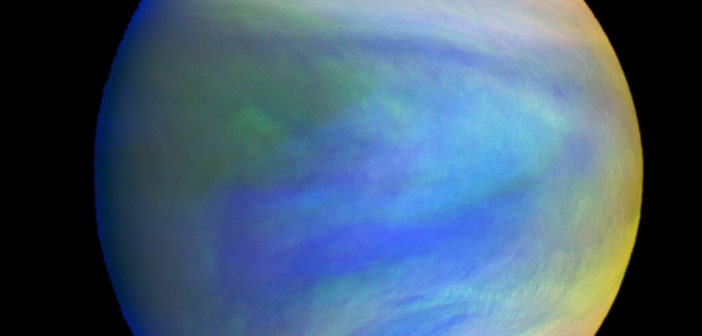Editor’s note: In these last two weeks of 2019, we’ll be looking at a few selections that we haven’t yet discussed on AAS Nova from among the most-downloaded papers published in AAS journals this year. The usual posting schedule will resume in January.
Long-term Variations of Venus’s 365 nm Albedo Observed by Venus Express, Akatsuki, MESSENGER, and the Hubble Space Telescope
Published August 2019
Main takeaway:
A new study led by Yeon Joo Lee (The University of Tokyo, Japan) has used an entire suite of instruments — Venus Express, Akatsuki, MESSENGER, and the Hubble Space Telescope — to study the long-term reflectivity of Venus’s atmosphere. They find that, over the timescale of roughly a decade, variations in the ultraviolet albedo of the atmosphere cause significant changes in aspects of Venus’s climate, like windspeeds at the planet’s cloud tops.
Why it’s interesting:

A comparison of Venus and Earth. Though they are nearly the same size and density, the two planets evolved very differently. [NASA]
From Lee and collaborators’ study, we can see that, like Earth, Venus has decade-long climate variations. Unlike on Earth, however, most of the Sun’s energy is absorbed by the planet’s atmosphere, rather than its surface. The decade of observations analyzed in this study provide new insight into Venus’s climate processes, demonstrating that Venusian weather is deeply influenced by ultraviolet absorption in the planet’s atmosphere.
Why these results provide extra intrigue:
Tracking how ultraviolet absorption in Venus’s atmosphere influences the planet’s climate is only part of the puzzle; the other part is understanding what is doing the absorbing. For more than a century, we’ve been aware that Venus has dark patches in its atmosphere that absorb light at ultraviolet to visible wavelengths, peaking at around 360 nm. But what are the patches made of, and why do they absorb ultraviolet light? Lee and collaborators’ analysis may help us to further study these “unknown absorbers” and identify the particles that they’re made up of.
Citation
Yeon Joo Lee et al 2019 AJ 158 126. doi:10.3847/1538-3881/ab3120
